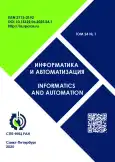Intelligent Agent-Controlled Elevator System: Algorithm and Efficiency Optimization
- Authors: Gharbi A.1, Ayari M.1, El Touati Y.1
-
Affiliations:
- Northern Border University
- Issue: Vol 24, No 1 (2025)
- Pages: 30-50
- Section: Robotics, automation and control systems
- URL: https://bakhtiniada.ru/2713-3192/article/view/278221
- DOI: https://doi.org/10.15622/ia.24.1.2
- ID: 278221
Cite item
Full Text
Abstract
The study introduces an innovative intelligent agent-controlled elevator system specially designed to improve passenger wait times and enhance the efficiency of high-rise buildings. By utilizing the classic single-agent planning model, we developed a unique strategy for handling calls from halls and cars, and combined with this strategy we significantly improved the overall performance of the elevator system. Our intelligent control methods are in-depth compared with conventional elevator systems, assessing three important performance indicators: response time, system capacity to handle multiple active elevator cars simultaneously, and average passenger waiting time. The results of the full simulation show that an intelligent agent-based model consistently exceeds conventional elevator systems in all measured criteria. Intelligent control systems have significantly reduced response times, and improved simultaneous elevator management and passenger wait times, especially during high traffic. These advances not only improved traffic flow efficiency, but also greatly contributed to passenger satisfaction and brought smoother and more reliable transport experiences within the building. Furthermore, the increased efficiency of our systems is in line with the goals of building energy management, as it minimizes unnecessary movements and idle time. The results demonstrate the system's ability to meet dynamic, high-occupation environment requirements and mark a significant step forward in intelligent infrastructure management.
About the authors
A. Gharbi
Northern Border University
Author for correspondence.
Email: Atef.gharbi@nbu.edu.sa
Al-Qadisyiah 37
M. Ayari
Northern Border University
Email: mohamed.ayari@nbu.edu.sa
Al-Qadisyiah 37
Y. El Touati
Northern Border University
Email: yamen.touati@nbu.edu.sa
Al-Qadisyiah 37
References
- Shen L.J., Lukose J., Young L.C. Predictive maintenance on an elevator system using machine learning. Journal of Applied Technology and Innovation. 2021. vol. 5(1). pp. 75–82.
- Hsu C.Y., Qiao Y., Wang C., Chen S.T. Machine learning modeling for failure detection of elevator doors by three-dimensional video monitoring. IEEE Access, 2020. vol. 8. pp. 211595–211609.
- Arrieta A., Ayerdi J., Illarramendi M., Agirre A., Sagardui G., Arratibel M. Using machine learning to build test oracles: an industrial case study on elevators dispatching algorithms. IEEE/ACM International Conference on Automation of Software Test (AST). 2021. pp. 30–39.
- Syed F.I., Alshamsi M., Dahaghi A.K., Neghabhan S. Artificial lift system optimization using machine learning applications. Petroleum. 2022. vol. 8(2). pp. 219–226.
- Gichane M.M., Byiringiro J.B., Chesang A.K., Nyaga P.M., Langat R.K., Smajic H., Kiiru C.W. Digital triplet approach for real-time monitoring and control of an elevator security system. Designs. 2020. vol. 4(2). doi: 10.3390/designs4020009.
- Zubair M.U., Zhang X. Explicit data-driven prediction model of annual energy consumed by elevators in residential buildings. Journal of Building Engineering. 2020. vol. 31. doi: 10.1016/j.jobe.2020.101278.
- Yao W., Jagota V., Kumar R., Ather D., Jain V., Quraishi S.J., Osei-Owusu J. Study and application of an elevator failure monitoring system based on the internet of things technology. Scientific Programming, 2022. doi: 10.1155/2022/2517077.
- Mao J., Chen L., Cheng H., Wang C. Elevator fault diagnosis and maintenance method based on Internet of Things. In International Conference on Mechatronics and Intelligent Control (ICMIC 2023). SPIE. 2023. vol. 12793. pp. 18–23.
- Sharma A., Chatterjee A., Thakur P.K., Jha S., Sriharipriya K. IoT Based Automated Elevator Emergency Alert System Using Android Mobile Application. IEEE International Conference on Data Science and Information System (ICDSIS). 2022. pp. 1–6.
- Wu Y., Yang J. Directional optimization of elevator scheduling algorithms in complex traffic patterns. Applied Soft Computing. 2024. vol. 158. doi: 10.1016/j.asoc.2024.111567.
- Wang H., Zhang M., Zhang R., Liu L. Research on predictive sliding mode control strategy for horizontal vibration of ultra-high-speed elevator car system based on adaptive fuzzy. Measurement and Control. 2021. vol. 54(3-4). pp. 360–373.
- Le S., Lei Q., Wei X., Zhong J., Wang Y., Zhou J., Wang W. Smart Elevator Control System Based on Human Hand Gesture Recognition. IEEE 6th International Conference on Computer and Communications (ICCC). 2020. pp. 1378–1385.
- Lu L., Jiang C., Hu G., Liu J., Yang B. Flexible noncontact sensing for human–machine interaction. Advanced Materials. 2021. vol. 33(16). doi: 10.1002/adma.202100218.
- Huang J., Wang H., Li J.A., Zhang S., Li H., Ma Z., Xin M., Yan K., Cheng W., He D., Wang X., Shi Y., Pan L. High-performance flexible capacitive proximity and pressure sensors with spiral electrodes for continuous human–machine interaction. ACS Materials Letters. 2022. vol. 4(11). pp. 2261–2272. doi: 10.1021/acsmaterialslett.2c00860.
- Koehler J., Schuster K. Elevator Control as a Planning Problem. In AIPS. 2000. pp. 331–338.
- Nivasanon C., Srikun I., Aungkulanon P. Aggregate production planning: A case study of installation elevator company. Proceedings of the International Conference on Industrial Engineering and Operations Management. 2021. pp. 5357–5365.
- Bagenda D.N., Basjaruddin N.C., Darwati E., Rakhman E. Development of an elevator simulator to support problem-based electric motor control practicum for vocational high school student. INVOTEK: Jurnal Inovasi Vokasional dan Teknologi. 2021. vol. 21(2). pp. 139–148.
- Cortes P., Munuzuri J., Vazquez-Ledesma A., Onieva L. Double deck elevator group control systems using evolutionary algorithms: Interfloor and lunchpeak traffic analysis. Computers & Industrial Engineering. 2021. vol. 155. doi: 10.1016/j.cie.2021.107190.
- Tartan E.O., Ciflikli C. Esra (elevator simulation, research & analysis): an open-source software tool for elevator traffic simulation, research, and analysis. Journal of Simulation. 2024. pp. 1–18.
- Gharbi A., Exploring Heuristic and Optimization Approaches for Elevator Group Control Systems. Applied Sciences. 2024. vol. 14(3). doi: 10.3390/app14030995.
Supplementary files









